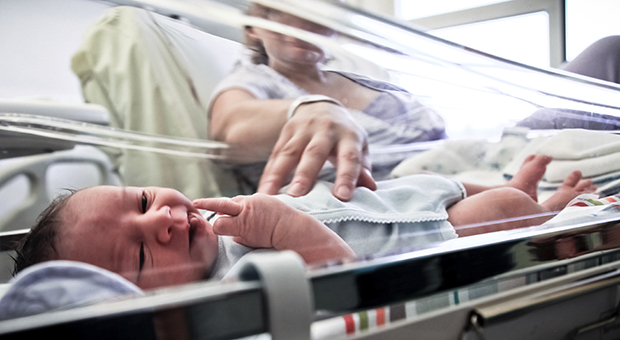The Medical Minute: Knowing when infant tummy troubles may be serious

Spitting up and occasional constipation are unfortunate – yet normal – facts of life for most infants.
“All babies experience reflux to at least some degree,” says Dr. Dorothy Rocourt, a pediatric surgeon at Penn State Hershey Children's Hospital. “Same with a couple days of constipation here and there.”
While those symptoms are seldom cause for concern, there are several more serious – albeit rare – warning signs that can present in the first hours and days of life that can indicate any of a number of congenital conditions.
“Different children are on different schedules,” Rocourt says. “However, a child having less than two bowel movements per week is when there may be cause for concern.”
Rocourt singles out two other symptoms as immediate cause for concern: vomit that is green in color and projectile vomiting.
“Neither of these is normal for an infant and should result in immediate medical attention,” Rocourt says. Over the longer term, failure to thrive – or lagging behind expected height and weight milestones – can also signal a more serious condition.
Some of the gastrointestinal illnesses pediatric surgeons treat include:
- Atresia, defined as the narrowing or absence of a portion of the digestive tract. Esophageal atresia with a connection into the lungs can lead to the flow of stomach fluids into the airway, causing inflammation of the lungs, inability to feed properly and, in some cases, respiratory distress. Intestinal atresia can cause green vomiting. Abdominal distension (ballooning of the stomach) can also be a symptom of atresia.
- Pyloric stenosis, or the abnormal thickening of the muscle around the connection between the stomach and the duodenum. Often, the child is hungry but unable to keep milk or formula down, resulting in projectile vomiting.
- Hirschsprung's disease, which occurs due to a lack of ganglion – the nerve cells that help the intestine to relax and allow food to keep moving through the body.
- Anorectal malformation, which involves the anal opening being in the wrong place.
- Malrotation, a very serious condition in which the intestines are situated abnormally, allowing the small intestine to twist and restrict or cut off the blood supply.
Depending on what conditions are suspected, diagnosis could involve a special x-ray or an enema study. All of them are treated with surgery. Sometimes, a single operation may be sufficient, while in more severe cases multiple surgeries may be required. Regular follow-up visits with a physician are also needed to ensure a healthy long-term outcome.
Rocourt adds it's important to understand that most of these conditions are relatively rare. The various forms of atresia occur in approximately one out of every 4,500 children, with pyloric stenosis being more common (approximately 1 percent of infants) and malrotation being less so (one in 6,000). She notes many of them are caught within the first day or two of life, before the infant has been discharged from the hospital.
“Children who are feeding, growing and meeting milestones are typically fine,” Rocourt says. However, it never hurts to call the pediatrician if any unusual symptoms surface.
Penn State Hershey Children's Hospital experts will answer questions about these and other gastrointestinal conditions during a live online chat on Friday, May 29 from 1 to 2 p.m. Learn more here.
The Medical Minute is a weekly health news feature produced by Penn State Milton S. Hershey Medical Center. Articles feature the expertise of Penn State Hershey faculty physicians and staff, and are designed to offer timely, relevant health information of interest to a broad audience.
If you're having trouble accessing this content, or would like it in another format, please email Penn State Health Marketing & Communications.
